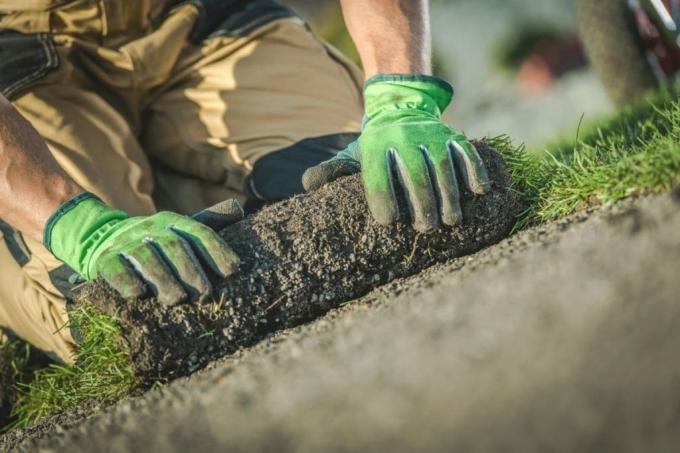
table of contents
- Turf
- How thick is turf?
- Importance of the thickness of the turf
- frequently asked Questions
More and more people are using turf for their garden design. No wonder, after a few weeks you have a closed, playable lawn. But how thick is turf actually? We answer your questions about turf dimensions.
In a nutshell
- Lawn thickness depends on the peeling machine
- standardized thickness about 2 cm
- important for quantity and quality determination
Turf
Turf turf is a natural product. It is used in special schools, so-called lawn schools. After about 12 to 14 months, the sward of the rolled turf is sufficiently thick and high that the lawn with a narrow layer of soil can be harvested with a sod peeler. Turf is not only beautifully green, but also evenly thick. The finished webs are then rolled up and put on the market.

Note: Once the lawn has been harvested, it must be done within 36 hours completely relocated otherwise it will turn yellow and start to rot.
How thick is turf?
Rolled turf is available in different sizes. Within one order, however, each sod contains the same size. The standard dimensions for 1m² turf typically correspond to the following values:
- Length: 250 cm
- Width: 40 cm
- Thickness / height: about 2 cm
- Weight: 15 to 20 kg
The thickness of the turf is usually composed of a layer of earth and the lawn growing over it. Like the other dimensions, it usually depends on the setting of the peeling machine. In addition to the standard dimensions, other dimensions are also available for the consumer. Larger dimensions are particularly suitable for large, commercial areas. These sods should then, however, be laid by machine.
Importance of the thickness of the turf
But why is it so important to know the height of the turf? Thickness is a sign of quality. Thicker turf can fall back on more soil and therefore more sewing material during transport and thus dries out less quickly. However, if you plant less high-quality turf correctly, the differences in quality can no longer be seen after 2 weeks. Also, the thickness is important
- for calculating the required amount of turf
- when preparing the Topsoil in the garden (only 13 to 18 cm required, instead of the conventional 15 to 20 cm)

Note: In order for the turf to be flush with the mowed edge, the thickness of the turf has to be taken into account when excavating the lawn beforehand. Since turf already contains soil, you need less of your own soil to reach the desired height.
frequently asked Questions
A sod is a cut, usually square piece of sod.
Depending on the quality and type of lawn, the material costs are between two and eight euros per square meter. In addition, there are usually additional costs due to delivery, fertilizer or relocation. This means that a square meter of turf can cost up to 18 euros.
The thickness depends on the setting of the respective peeling machine and therefore varies from company to company. However, there is usually no significant difference in thickness between the classic types of play lawn, shadow lawn and premium lawn. However, special types of lawn differ in thickness.
Careful entry is possible immediately, but not advisable. If the load is too high, the growth process could be disturbed. Avoid entering it for the first two weeks. The lawn is completely playable after 6 to 8 weeks.



